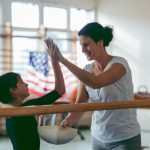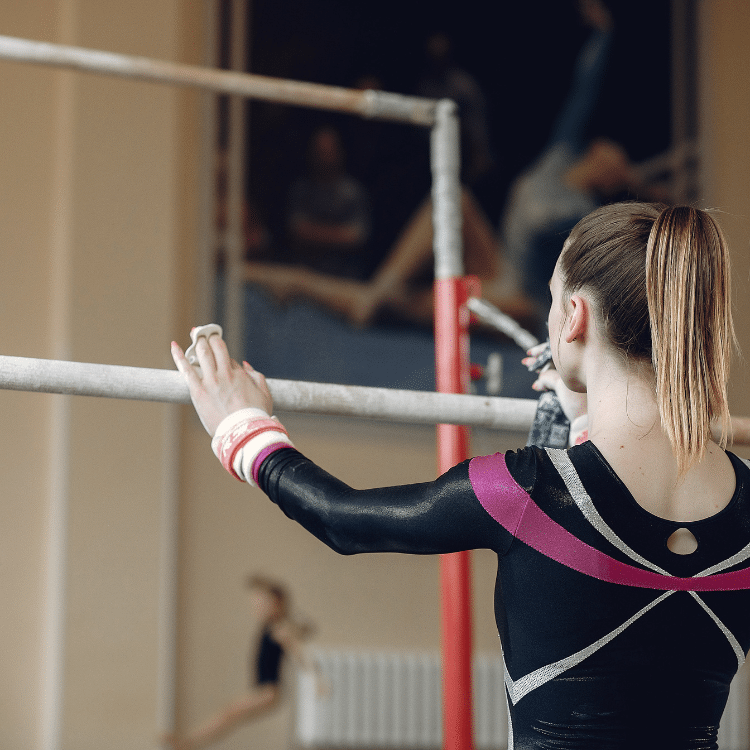
Ever wondered what is a Kip in gymnastics? Within gymnastics, one move that holds significant importance and serves as a foundation for various other skills on the bars is the Kip.
In this article, we will delve into the world of bars and discover why the Kip is a foundation skill, understanding its technique, benefits, and how to master it.
Disclaimer: This article should be considered generic information and does not replace the need for professional guidance in a recognized facility.
Introduction to Kip in Gymnastics
The kip is a fundamental skill in artistic gymnastics, commonly performed on uneven bars, but it can also be executed on other apparatus such as the high bar or parallel bars. It involves a complex and coordinated movement that transitions from a hanging position to a support position, allowing the gymnast to generate momentum for subsequent skills. Mastering the kip is crucial for gymnasts as it sets the stage for more advanced skills and routines.
| Skill | Kip |
| Apparatus | Uneven Bars, Parallel Bars High Bar, Rings |
| Difficulty | Intermediate |
| Level | Level 4 USAG Development Program (Women’s Artistic) |
| Value | 0.1 A-Value group |
Understanding the Basics of the Kip
To grasp the concept of a kip, let’s break it down into its fundamental components. The kip consists of several stages: the glide swing, the leg lift, the hip extension, the pull-up, and the transition to a support position. Each stage requires precise timing, strength, and body control. A well-executed kip allows the gymnast to seamlessly transition between movements while maintaining a fluid and controlled rhythm.
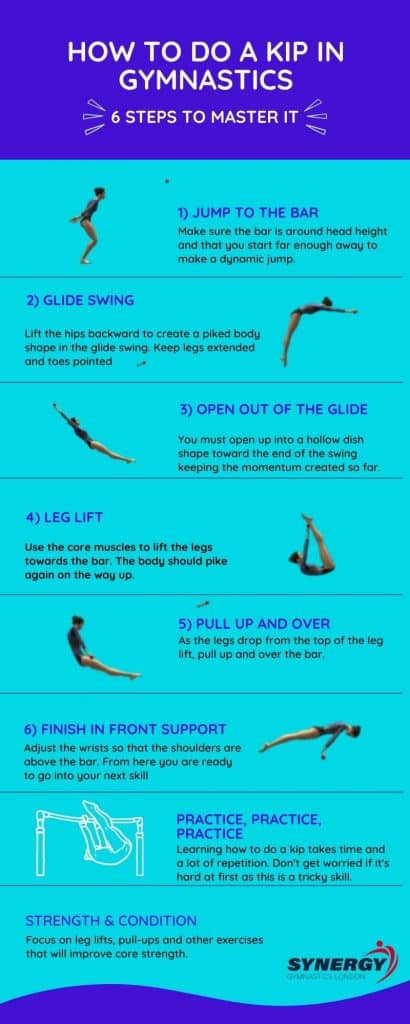
As with any skill, there are common mistakes that gymnasts should avoid during the kip. These include relying solely on upper body strength, failing to engage the core muscles, improper body alignment, and neglecting the importance of a strong grip.
Benefits of Learning a Kip
Mastering the kip offers numerous benefits for gymnasts of all levels. Firstly, the kip greatly enhances upper body strength, particularly in the shoulders, arms, and core. This increased strength allows gymnasts to perform more demanding skills with ease and precision.
For this reason alone mastering the kip is considered a real milestone.
Furthermore, the kip improves coordination and body control. It requires the synchronization of various muscle groups, promoting a greater understanding of how the body moves in space. This heightened awareness translates to better execution of other gymnastics elements, such as transitions and releases.
Lastly, the kip acts as a stepping stone for gymnasts who aspire to perform more advanced skills. Once the kip is mastered, gymnasts can progress to skills like the cast handstand, giants, and release moves. These skills are often seen in high-level routines and competitions, and the kip serves as the foundation for their execution.
How to do a Kip
To effectively learn the kip, it is essential to follow a structured approach. Begin with a thorough warm-up, incorporating exercises that target the upper body and core muscles. This prepares the body for the physical demands of the kip and helps prevent injuries.
Once warmed up, follow this step-by-step guide to perform the kip:
- Gymnasts start on the floor facing the bar which should be just above head height. They jump and reach forwards, grasping the bar in flight to create a swing.
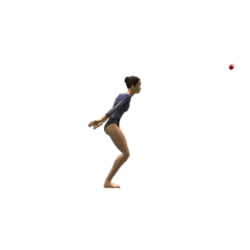
- Pike the body by lifting the hips backward and keeping the legs lifted and extended as the glide swing begins.
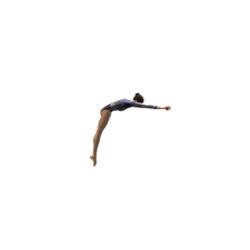
- The gymnast should glide swing under the bar maintaining a piked body shape before opening up into a hollow dish shape near the end of the glide.
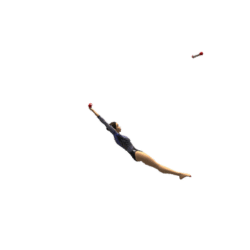
- Next is the leg lift which requires a strong core to lift both legs to the bar until the toes are touching. When performed correctly the legs will stay straight and extended throughout. It’s important to lift the legs all the way up as this will create enough momentum for the final part of the kip.

- As the legs drop from the top of the leg lift begin to pull up and over the bar into a front support position. This is often the trickiest part of the kip as the gymnast has to learn to pull the upper body upwards as the lower body falls. The gymnast has to use the momentum created instead of fighting against it.

- Once in the support position aim to keep the shoulders above the bar. The gymnast may need to adjust the wrist and hand position in order to do this.

To speed up the learning process, consider the following tips:
- Seek guidance from experienced gymnastics coaches or instructors who can provide personalized feedback and corrections. Professional guidance is always safer than being a self-taught gymnast.
- Many gymnasts use a bar at home to practice the Kip. Many home bars are referred to as Kip bars.
- Incorporate targeted strength and conditioning exercises into your training to build the necessary muscle groups.
- Practice regularly and be patient with your progress. Mastery of the kip takes time and dedication.
Variations and Progressions of the Kip
Once you have mastered the basic kip, you can explore various variations and progressions. Some examples include the straddle kip, where the legs are opened in a wide “V” shape during the lift, and the clear hip, which involves a continuous hip circle movement. These variations challenge your coordination, flexibility, and strength while adding complexity to your routines.
As you become more proficient in your kip, you can incorporate it into gymnastics routines and competitions. Combine the kip with other skills like releases, pirouettes, and dismounts to create dynamic and captivating performances that impress judges and spectators alike.
Common Challenges and How to Overcome Them
Learning the kip can present challenges for gymnasts, both physically and mentally. One common hurdle is overcoming fear and building confidence in executing the movement. This can be addressed by gradually progressing through drills and exercises that build familiarity and trust in your abilities.
Physical limitations or lack of strength may also pose challenges. In such cases, focus on strengthening the relevant muscle groups through targeted exercises and conditioning. Consult with your coach or a sports therapist to develop a tailored training plan that addresses your specific needs.
Remember that seeking guidance from experienced coaches and experts is invaluable when facing challenges during your kip journey. They can provide personalized advice, technique adjustments, and support throughout the learning process.
Safety Considerations for the Kip
Safety should always be a top priority when practicing gymnastics skills, including the kip. Ensure that you perform the kip with proper technique and body alignment to minimize the risk of injury. Engage your core muscles and maintain a neutral spine throughout the movement.
Before attempting the kip, warm up adequately and perform conditioning exercises that target the muscles involved. This helps prevent strains, sprains, and other common gymnastics-related injuries. Be mindful of signs of fatigue or overexertion, and take breaks as needed to allow your body to rest and recover.
By prioritizing safety and practicing with proper form, you can enjoy the benefits of the kip while minimizing the risk of injury.
Conclusion
If you were wondering what is a kip in gymnastics, hopefully this guide has been able to fully answer that question!
By following a structured progressions, support of a professional coach, and practicing with dedication, gymnasts of all levels can unlock the power of the kip and take their gymnastics journey to new heights.
So, what are you waiting for? Start practicing the kip today and embrace the challenges and rewards that come with it. Remember, consistency and perseverance are key. Get ready to soar, swing, and excel in the captivating world of gymnastics!
If you’re interested in learning how to learn a kip in a safe and friendly environment, book a free trial class using our parent portal.
Frequently Asked Questions
How long does it take to learn a gymnastics kip?
The time it takes to learn the kip varies from individual to individual. It depends on factors such as age, prior gymnastics experience, strength, and dedication to practice. With consistent training and guidance, it is possible to learn the kip within a few months.
What level skill is a kip?
A kip is a requirement of level 4 in the Women’s Development Program. This means a gymnast has to perform it as part of the bar routine in order to move up to level 5. There are 10 levels in total.
What does kip mean in gymnastics?
Kip in artistic gymnastics means the gymnast has to fold or pike at the hips then quickly push the hips forward to create a swing. The kip is performed on the uneven bars (female) or high bar (male).
Is it necessary to have a spotter when learning the kip?
Having a spotter can provide an added sense of security and support when learning the kip, especially for beginners. A spotter can assist in maintaining body alignment, provide guidance, and help prevent falls or accidents. However, as gymnasts gain proficiency, they may choose to practice the kip independently under the supervision of a coach.
- How to Do a Back Handspring: Complete Step-by-Step GuideLearning how to do a back handspring is an exciting milestone for any gymnast. It builds confidence, agility, and forms the foundation for advanced tumbling… Read more: How to Do a Back Handspring: Complete Step-by-Step Guide
- How To Get Over a Mental Block In Gymnastics: A Complete GuideGymnastics is a sport that requires not only physical strength and skill but also mental strength. When a gymnast feels like they cannot attempt a… Read more: How To Get Over a Mental Block In Gymnastics: A Complete Guide
- The Best Leotard for Girls in 2025: What to Look ForFinding an ideal leotard for girls isn’t just about picking a dazzling design that sparkles (although it does help!). The leotard has to fit perfectly,… Read more: The Best Leotard for Girls in 2025: What to Look For
- The Best Gymnastics Shorts (Our Top Picks)The best gymnastics shorts are designed to be worn over the top of a leotard providing additional coverage around the upper legs, whilst allowing gymnasts… Read more: The Best Gymnastics Shorts (Our Top Picks)
- Decathlon Leotards – Are They Any Good?If you’re in the market for a new leotard, you may be wondering if Decathlon leotards are any good considering the low cost of their… Read more: Decathlon Leotards – Are They Any Good?
- A Complete Guide to Gymnastics Hand RipsAre you tired of dealing with painful gymnastics rips on your hands from training? Look no further – this article offers a comprehensive approach to… Read more: A Complete Guide to Gymnastics Hand Rips


